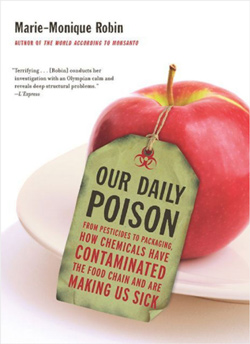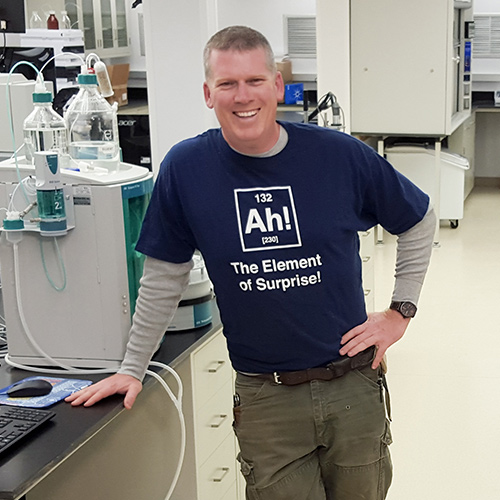
But it turns out Alex Jones is correct. As the lab science director of CWC Labs, I not only conduct mass spec analyses of pesticides and herbicides in foods, but I also have access to a massive library of published books describing the toxic effects of hundreds of different pesticides. Atrazine is widely documented as a "powerful chemical castrator" that transforms males into hermaphrodites, the animal kingdom version of a "metrosexual." It's also widely present in the U.S. water supply. It is undoubtedly one of the chemicals currently responsible for the mass feminization of men in modern society.
To explain the science, I'm republishing an excerpt from the book Our Daily Poison - From Pesticides to Packaging How Chemicals Have Contaminated the Food Chain and Are Making Us Sick by Marie-Monique Robin, published in 2014. Click here to pick up the book at BN.com (don't shop at Amazon.com, as its profits fund the fake news propaganda rag known as the Washington Post).
(Note to InfoWars and other indy media outlets: We can run research on any topic across over 1,000 printed reference books, using an automated system I built. So if you need supporting documentation on atrazine, glyphosate, BPA, medicinal herbs, vitamins or other molecules of interest, just ask me for a research compilation. In addition, my lab can easily detect atrazine in water, so if you want to grab water from Austin and have my lab test it, that's a cinch. Imagine being able to publish a story, "Austin water supply found contaminated with feminization chemicals that turn men into metrosexuals..." We can literally run that research in just a few hours on various water samples from across the city.)
"The males became homosexuals and coupled with other males, adopting a feminized behavior... atrazine acted as a very powerful chemical castrator"
The most astonishing and relevant passage from this book is as follows, relating the findings from a brilliant scientist (Tyrone Hayes) who studied the effects of atrazine on males and the endocrine system:
"We observed that atrazine reduced the size of the larynx, which is the voice box in the males. Since they sing to seduce the females, this meant they were sexually handicapped. We also observed very low levels of testosterone among the adult males; some of them were hermaphrodites, which means they had both ovaries and testes. In certain cases, the males became homosexuals and coupled with other males, adopting a feminized behavior; sometimes they had eggs in their testes instead of sperm. Ultimately, atrazine acted as a very powerful chemical castrator that is biologically active at 1 ppb, and even 0.1 ppb.”
Tyrone Hayes maintains a very informative website called AtrazineLovers.com. (RELATED: We will soon be launching two news websites covering all this: Atrazine.news and Pesticide.news. Be sure to watch for them soon. We already run Glyphosate.news as well.) Not surprisingly, the pro-GMO, pro-pesticide industry has gone to great lengths to try to discredit and destroy Hayes, just like they do anyone who dares conduct actual science on agricultural chemicals or GMOs.

Atrazine: A "Powerful Chemical Castrator”
Excerpted from the book, bolding added for emphasis
During the New Orleans symposium, Tyrone Hayes evoked one of his latest studies showing that atrazine, an agricultural poison, provoked mechanisms characteristic of breast and prostate cancers in human cells exposed to doses similar to those found in the environment.* “You’ve all heard the good news," he exclaimed. “The Environmental Protection Agency [EPA] has announced that it will reexamine atrazine’s scientific file! Let’s hope it will end up banning it just like Europe did five years ago!" Though the herbicide was banned by the European Union in 2004, it is still massively used throughout the United States, where approximately forty thousand tons are spread on countless farms growing crops such as corn, sorghum, sugar cane, and wheat every year.'’ Lauded as the “DDT for weeds” when it was put on the market in 1958, today atrazine is the principal contaminant of American surface and ground waters, much like in the majority of European countries (with France in the lead), despite the ban.
Two weeks before the New Orleans symposium, Lisa Jackson, the EPA director nominated by President Barack Obama in January 2009, had effectively announced that the agency would “conduct a new evaluation of the pesticide to assess any possible links between atrazine and cancer, as well as other health problems, such as premature births.” “This is a dramatic change," said Linda Birnbaum, director of the National Institute of Environmental Health Sciences (NIEHS) (see Chapter 18). “There is growing evidence that atrazine could be a hazard to human health. This is a strong signal that the world is changing in regards to some of the most widely used chemicals."
If there is one scientist who battled for atrazine’s ban in the United States, it is inarguably Tyrone Hayes, even if (as he explained to me during our meeting in his Berkeley laboratory on December 12, 2009) “this battle wasn’t a personal decision, but was imposed by events." In 1998, he was contacted by Novartis (the company became Syngenta two years later after its merger with AstraZeneca), which offered him a “handsomely paid” contract to “verify if atrazine [was] an endocrine disruptor," as Theo Colborn and her co-authors note in Our Stolen Future (see Chapter 16). For the industry, the matter was quite serious as, seven years earlier, a U.S. Geological Survey report had revealed that “atrazine exceeded drinking water standards in 27 percent of the samples” taken from the Missouri, Mississippi, and Ohio Bivers and tributaries. What’s more, in the 1980s, two studies conducted on mice and rats had indicated that exposure to the herbicide brought on breast and uterine cancers, lymphomas, and leukemia. The International Agency for Research on Cancer (IARC) judged the results sufficiently convincing and decided to classify atrazine as “possibly carcinogenic to humans” (group 2B) in 1991. As a result, the EPA, leaning on the Safe Drinking Water Act, decreased the atrazine standard to a maximum of 3 ug/l of water, or 3 ppb (parts per billion). In 1994, three studies established a link between rodents' exposure to atrazine and mammary tumors. Then in 1997, one year after the publication of Our Stolen Future, an epidemiological study carried out in several rural Kentucky counties found a significant excess of breast cancer among the most exposed women (in correlation with the level of water contamination and proximity of the home to corn cultivations).
Thus began Novartis’ great strategic era. Its first tactic was tremendously effective, and brought about IARC’s downgrade of atrazine from group 2B to group 3 (not classifiable) in 1999. To justify the surprising decision, the UN agency experts relied on a line of reasoning I described in Chapter 10: “the mechanism by which atrazine increases the incidence of mammary gland tumors in rats is not relevant to humans.”
Novartis' second effort revolved around Tyrone Hayes, a brilliant biologist (and the youngest tenured professor at Berkeley) and an amphibian enthusiast who named his daughter Kassina, after an African frog species. “Frogs are my entire life,” he explained to me in his laboratory, surrounded by thousands of jars filled with amphibians. “I grew up in the country, in South Carolina, and I was always fascinated by their ability to metamorphose—from an egg to a tadpole, and then to an adult frog.”
“Why do frogs provide an interesting model from which to study the effects of endocrine disruptors?” I asked.
“They’re a perfect model!" responded the biologist. “First of all, because they're very sensitive to hormones that enable the activation of genes necessary for their various metamorphoses; and then, because they possess exactly the same hormones as humans, such as testosterone, estrogen, or the thyroid hormone.”
“How did you go about your study?”
"I should clarify that this process was closely monitored by Novartis, and then Syngenta. Initially, we raised frogs from the Xenopus laevis family in water reservoirs to which we had added different doses of atrazine, similar to what’s found in field drainage ditches and up to thirty times lower than the existing U.S. standard (3ppb)—meaning levels that a human being might find in tap water. To give you an idea, that’s the equivalent of a grain of salt in a reservoir of water. We observed that atrazine reduced the size of the larynx, which is the voice box in the males. Since they sing to seduce the females, this meant they were sexually handicapped. We also observed very low levels of testosterone among the adult males; some of them were hermaphrodites, which means they had both ovaries and testes. In certain cases, the males became homosexuals and coupled with other males, adopting a feminized behavior; sometimes they had eggs in their testes instead of sperm. Ultimately, atrazine acted as a very powerful chemical castrator that is biologically active at 1 ppb, and even 0.1 ppb.”
"Do you know if wild frogs were presenting the same problems?”
“That was actually the second stage of our study: we set out with a refrigerated truck across Utah and Iowa where we collected eight hundred young leopard frogs (Rana pipiens) in ditches alongside fields, near golf courses or riverbanks. We dissected them and observed exactly the same dysfunctions that we had seen in the laboratory frogs. It was very upsetting, and that's when I understood that the decline in North American and European frog populations was due to pesticide contamination that affected their reproduction systems."
"How do you explain this phenomenon?”
“Atrazine stimulates an enzyme called ‘aromatase,’ which transforms the masculine hormone, testosterone, into the female hormone, estrogen. As a result, the estrogen produced by the aromatase leads to the development of female organs, like ovaries or ovules in the testes. However, the levels of aromatase are also linked to the development of breast or prostate cancers. An epidemiological study conducted in a Syngenta atrazine factory in Louisiana, published in 2002, actually indicated a significant excess of prostate cancer among workers.”
“How did Syngenta react?"
"Ah!” sighed Tyrone Hayes. "I was very naive at the time! At first, the company asked me to repeat my study to verify that I would obtain the same results. They offered me 2 million dollars for it and, initially, I accepted . . . Then, I understood their strategy—they wanted to drag things out to gain some time and stop me from publishing. I finally terminated the contract and I published my results in 2002.18,19 After that, it was war! And I have to say that I never could have imagined that it would be so violent: Syngenta wrote to the dean of UC Berkeley, used the press to discredit me, added a link on its website to junkscience.com, Steven Milloy’s site, where I ended up on the list of ‘junk scientists' [see Chapter 8]. Today, it makes me laugh because I know that appearing on that list is proof that I was doing good work! They then paid scientists to conduct new studies that, of course, were unable to reproduce my results. Their goal was to create doubt, and it worked, at least in the United States where the EPA ultimately renewed its approval of atrazine in 2007.”
In fact, in October 2007, the EPA produced a report that concluded: “Atrazine does not adversely affect amphibian gonadal development: no additional studies are required.” Meaning that the unstoppable machine created to destroy any and all uncomfortable truths had, once again, worked marvelously.
At the height of the drama, Tyrone Hayes published an article in BioScience in which he deciphered the immutable cogs that 1 have described throughout this book: manipulations of science, the funding effect, defamation campaigns, the public authorities’ complacency, media brainwashing, etc.
Pesticide Mixtures Enhance Individual Effects
"Industry has increased efforts to discredit my work, but my laboratory continues to examine the impacts of atrazine and other pesticides on environmental and public health," writes Tyrone Hayes on his website, ironically named atrazinelovers.com. “My decision to stand up and face the industry giant was not a heroic one. My parents taught me, ‘Do not do the right thing because you seek reward . . . and do not avoid the wrong thing because you fear punishment. Do the right thing, because it is the right thing.’”
“My quarrels with Syngenta marked a turning point in my career," explained the Berkeley researcher, “because that’s when I began to specialize in a little-explored field: the effects of pesticide mixtures. The leopard frogs that I collected from fields in the Midwest weren't exposed uniquely to atrazine, but rather to a combination of several substances. However, scientific literature is generally only interested in the toxicological effects of pesticides at relatively high doses (in the realm of parts per million), but rarely in low doses and even less so in mixtures of low doses, like those that exist in our everyday environment, namely in tap water and the fruits and vegetables we eat."
This "omission"—on the whole quite surprising, and which also characterizes the regulatory system of chemical products—was similarly highlighted by the U.S. Geological Survey in a 2006 report that is all the more remarkable because it openly describes the pollution of America’s surface and ground waters: “Because of the widespread and common occurrence of pesticide mixtures, particularly in streams, the total combined toxicity of pesticides in water or other media often may be greater than that of any single pesticide compound that is present,” writes Robert Gilliom, the principal author. He adds that their findings indicate that the study of mixtures should be an absolute priority.
And so Tyrone Hayes once again hopped aboard his refrigerated truck to cross Nebraska and collect thousands of liters of “chemical brew” flowing through industrial cornfields. Once he returned to Berkeley, he identified nine recurring molecules: four herbicides, including atrazine and alachlor (or
Lasso, which caused Paul Frangois’s poisoning; see Chapter 1), three insecticides, and two fungicides. When I met him, he was working on another mixture composed of five pesticides, including Roundup and chlorpyrifos. The scientist conducted each study in two ways: he raised frogs in reservoirs filled with the “brew” from the fields, as well as in the mixture he reconstituted in his laboratory in order to compare the results. And in both cases, the results were very troubling.
"When we mixed the substances, we noticed effects we hadn’t seen with products taken separately,” he explained. “First off, we observed weakened immune systems in the frogs due to thymus disorders, which meant they were more susceptible to, for example, meningitis, and that they died of diseases more often than frogs in the control group. That immune weakness can explain, in part, the population declines. But added to it is the disruption to reproductive systems, similar to what I observed with atrazine on its own. Finally, the mixtures had an effect on metamorphosis time and larva size. And yet, the doses we were using were up to a hundred times lower than the residue level authorized in water.”
"What can we conclude about humans from that?”
"We have no idea!” responded Tyrone Hayes. “But what’s incredible is that the pesticide evaluation system has never taken into account the fact that substances can interact or accumulate, or even create new molecules. It’s even more surprising given that pharmacists have known for centuries that it’s imperative to avoid mixing certain medications, at the risk of exposing oneself to serious side effects. For that matter, when the FDA authorizes a new drug, it always insists that the medicinal contraindications be detailed in the user instructions. Clearly, this kind of precaution is difficult to implement for pesticides. Imagine the EPA explaining to farmers: you can use pesticide A, as long as your neighbor at the farm next door doesn’t use pesticide B or C! It’s impossible! And, if it’s impossible, it means that these products have no business in the fields. In the meantime, knowing the ‘chemical body burden’ that characterizes every citizen in industrialized countries, we can effectively fear the worst.”
Get the book to read more
The book you want to get on this is called: Our Daily Poison - From Pesticides to Packaging How Chemicals Have Contaminated the Food Chain and Are Making Us Sick by Marie-Monique Robin, published in 2014. Click here to pick up the book at BN.com.

Mike Adams (aka the "Health Ranger") is the founding editor of NaturalNews.com, a best selling author (#1 best selling science book on Amazon.com called "Food Forensics"), an environmental scientist, a patent holder for a cesium radioactive isotope elimination invention, a multiple award winner for outstanding journalism, a science news publisher and influential commentator on topics ranging from science and medicine to culture and politics.
Mike Adams also serves as the lab science director of an internationally accredited (ISO 17025) analytical laboratory known as CWC Labs. There, he was awarded a Certificate of Excellence for achieving extremely high accuracy in the analysis of toxic elements in unknown water samples using ICP-MS instrumentation.
In his laboratory research, Adams has made numerous food safety breakthroughs such as revealing rice protein products imported from Asia to be contaminated with toxic heavy metals like lead, cadmium and tungsten. Adams was the first food science researcher to document high levels of tungsten in superfoods. He also discovered over 11 ppm lead in imported mangosteen powder, and led an industry-wide voluntary agreement to limit heavy metals in rice protein products.
Adams has also helped defend the rights of home gardeners and protect the medical freedom rights of parents. Adams is widely recognized to have made a remarkable global impact on issues like GMOs, vaccines, nutrition therapies, human consciousness.
Please contact us for more information.























